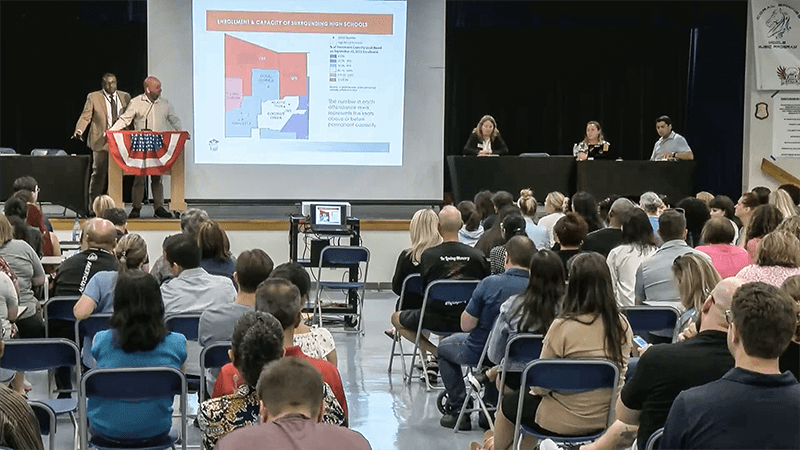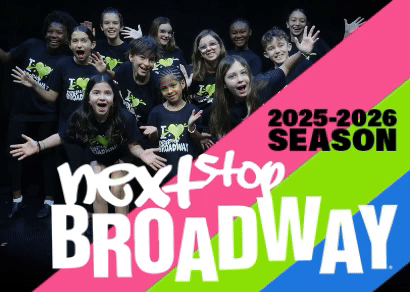Coral Springs, Parkland Parents Attend School District Meeting on Possible Boundary Changes to MSD
October 6, 2022 • By Guest Contributor[caption id="attachment_42607" align="aligncenter" width="800"] October 3 boundary meeting held at Coral Springs Middle School. {Becon.TV}[/caption]
October 3 boundary meeting held at Coral Springs Middle School. {Becon.TV}[/caption]
By Jonathan Schaefer
Several hundred community members joined Broward County Public Schools officials to discuss a plan for easing the high capacity at Marjory Stoneman Douglas by adjusting the boundaries.
Director of Demographics and Enrollment Planning Jill Young and Demographer Specialist Joseph Beck led the meeting, with School Board members Debra Hixon and Lori Alhadeff in attendance.
Both Young and Beck informed parents who live within the boundaries of Marjory Stoneman Douglas of the overcrowding issues -- and the unfortunate glut of 45,000 open seats throughout the district.
Their goal was to introduce a planning process for changing school boundaries, understand the community priorities, and develop scenarios before proposals are in by Oct. 31.
Marjory Stoneman Douglas has been at full capacity at 3,077 students since 2015-2016 and is on pace to reach 116% capacity this year at 3,511 students.
While MSD, Monarch, and Coral Glades have all reached or exceeded capacity, others like Coral Springs High, J.P. Taravella, Atlantic Tech, and Coconut Creek High School are currently under-enrolled.
Beck detailed how growing housing developments may increase the overcrowding issues for Marjory Stoneman Douglas. For example, new residents of Parkland subdivisions Parkland Bay, Parkland Royal Phase II, and Pinetree Estates could generate even more students for the overcrowded high school.
Coral Springs developments Windsor Square, Wyndham Lakes Plaza, Capri Island Townhomes, City Village, and the new Cornerstone in Downtown Coral Springs will increase the number of students slated for Marjory Stoneman Douglas.
Beck expressed a need to work with community members asking for their input and boundary proposals.
A detailed list of general considerations for boundary proposals includes the following:
Class size impact - will the requested change place any school involved in jeopardy of not meeting the Florida class size statute now or in the next five years?
Level of service impact - are the schools involved projected to meet the tri-party agreement (Broward County, municipalities, School Board) school concurrency level of service?
Enrollment Impact - will the requested change under-enroll a school or cause it to exceed its gross capacity?
Diversity Impact - will the proposed boundary change impact any demographic population significantly (+/- 5%)?
Feeder Pattern Impact- Does the requested change split or further divide the number of students feeding from one school to another?
School Proximity Impact-will the requested change require students to travel further to get to school?
Neighborhood Integrity Impact- will the requested change assign students living in a neighborhood to different schools?
Natural Barrier Impact- will the requested change require students to cross natural barriers such as major roads or waterways?
In addition to the general considerations, viable boundary proposals for MSD should follow these rules according to the district.
1. Be contiguous (sharing a common border).
2. Be as compact as practicable.
3. Don’t shift more than 400 total students out of MSD.
4. May split Traffic Analysis Zones (TAZ) if necessary but should keep neighborhoods intact.
5. Not target any demographic or socioeconomic group. For example, renters.
6. May not propose moving an area into a school that's currently at or above capacity.
Following the meeting, Young and Beck listened to questions and concerns from the community.
Parents asked if juniors or children who currently walk to MSD would be redistricted.
According to Beck, anyone who is already enrolled and completing Marjory Stoneman Douglas would not be a part of the student shift. Students who walk to school could be affected at the discretion of the School Board.
Several parents expressed anger, fearing they moved to certain areas of Broward County specifically for the higher-rated high schools and worry redistricting will send their children to less desired institutions.
A common inquiry was, “Why can’t we build a new high school?”
Beck explained that Florida’s Education Department would not allow Broward County to construct new buildings while some schools are below capacity.
Parkland Mayor Rich Walker, who voted yes to changing Parkland Royal from being a 55+ community, believed it was important for the school district to get the community engaged because, ultimately, the community needs to present the proposal to the school board.
"Ultimately, the school board makes the final determination of what it’s going to be. It’s an unfortunate situation, nobody wants to be in this place, so we’ll see what happens at the end of the process," he said.
For more information on submitting a boundary proposal, visit browardschools.com/boundaryprocess before the October 31 deadline. The next community meeting takes place at 6:30 p.m. Thursday, November 3, 2022, at Coral Springs Middle School 10300 Wiles Road. The first School Board Boundary Public Hearing is scheduled for February 2023.
Send Your News to Coral Springs #1 Award-Winning News Site Here. Don't miss reading Margate Talk, Parkland Talk, and Tamarac Talk.








